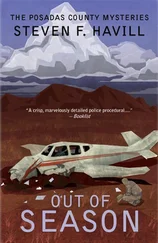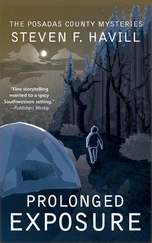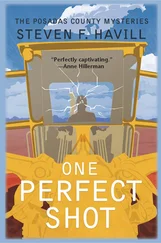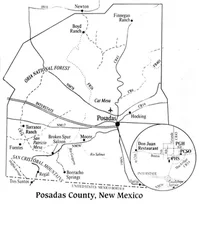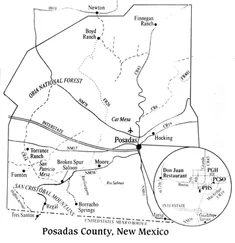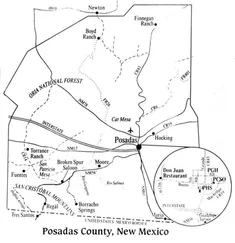Steven Havill - Before She Dies
Здесь есть возможность читать онлайн «Steven Havill - Before She Dies» весь текст электронной книги совершенно бесплатно (целиком полную версию без сокращений). В некоторых случаях можно слушать аудио, скачать через торрент в формате fb2 и присутствует краткое содержание. Год выпуска: 2011, ISBN: 2011, Издательство: Poisoned Pen Press, Жанр: Полицейский детектив, на английском языке. Описание произведения, (предисловие) а так же отзывы посетителей доступны на портале библиотеки ЛибКат.
- Название:Before She Dies
- Автор:
- Издательство:Poisoned Pen Press
- Жанр:
- Год:2011
- ISBN:978-1-61595-074-4
- Рейтинг книги:3 / 5. Голосов: 1
-
Избранное:Добавить в избранное
- Отзывы:
-
Ваша оценка:
- 60
- 1
- 2
- 3
- 4
- 5
Before She Dies: краткое содержание, описание и аннотация
Предлагаем к чтению аннотацию, описание, краткое содержание или предисловие (зависит от того, что написал сам автор книги «Before She Dies»). Если вы не нашли необходимую информацию о книге — напишите в комментариях, мы постараемся отыскать её.
Before She Dies — читать онлайн бесплатно полную книгу (весь текст) целиком
Ниже представлен текст книги, разбитый по страницам. Система сохранения места последней прочитанной страницы, позволяет с удобством читать онлайн бесплатно книгу «Before She Dies», без необходимости каждый раз заново искать на чём Вы остановились. Поставьте закладку, и сможете в любой момент перейти на страницу, на которой закончили чтение.
Интервал:
Закладка:
After crossing the bridge, the highway fishtailed a little, dipping through the grove of cottonwoods that surrounded the Broken Spur Saloon.
Monday at suppertime would be slow, and a good time to capture Victor Sanchez’s full attention, but I didn’t pull off the highway. I scanned the parking lot as I drove by. There were two pickup trucks, one with a long livestock trailer attached. The trailer was empty. Half of the ranchers drove around with the humongous things permanently attached to their trucks, clanging and banging over every bump in the road. I figured it was a kind of status symbol.
Three miles down the highway was the turnoff to the north-County Road 14, a dusty ribbon that wound up through the prairie and the old lava beds, past windmills and stock tanks, and up over the top of San Patricio Mesa. It had been down that jouncing two-track that Francisco Pena’s old GMC pickup had trundled the night before.
I drove southwest, toward that intersection with the county road. My hands involuntarily gripped the steering wheel tighter as the white lines clicked by. Pena would have pulled up at the stop sign, at which point he would have been able to see the headlights of the parked patrol car a quarter-mile east, to his left.
A dark smudge and some white chalk on the pavement, along with a few trampled weeds on the shoulder, were all that marked the spot. I slowed 310 to an idle. An oncoming car dashed by, no doubt curious why anyone would stop in the middle of nowhere.
Paul Encinos and Linda Real would have had no reason to do so unless another vehicle was stopped along the shoulder of the road.
In another quarter of a mile, I turned right onto County Road 14, and as 310’s front tires crunched onto gravel, the late afternoon sun winked off metal to my left, further up the highway. Someone was parked in a small grove of elms that struggled for life near one of the highway department’s stash of crushed stone.
I continued up the county road for half a mile and then turned around, nearly planting the front wheels of my patrol car in a small arroyo. As I drove back, I opened my window and took a deep breath. Francisco Pena said he didn’t see anything until he actually drove by the scene of the shooting. And true enough, most of County Road 14 ambled up and down through dips and cuts and arroyos, around runty stands of juniper and cholla. The state highway intersection wasn’t visible until I approached within a hundred yards of the stop sign.
At any time during that hundred yards, though, I could see east along the state road. Had there been more than one vehicle parked along the shoulder of the highway, Francisco Pena would have been able to see it.
I hesitated at the stop sign and then turned right. The car I had seen was parked behind a mound of crusher fines, impossible to see eastbound, and not much more than a glint for westbound traffic. I circled the pile, drove around a parked asphalt roller, and pulled up beside the other vehicle.
I saw the passenger side window buzz down and I switched off the engine of the patrol car.
In the distance I could hear oncoming traffic, so I waited until it shot past-a single late-model sedan with New Mexico plates. The tire noise faded and that wonderful, heavy silence of the open prairie settled once more.
Estelle Reyes-Guzman looked across at me. From the lack of radio traffic, she knew as well as I did that our roadblocks sealing Posadas County had produced nothing but expense and inconvenience.
I wasn’t particularly surprised to find her parked in the middle of nowhere, with nothing but the sound of night winds, coyotes, and rare traffic for company. As a little kid growing up in northern Mexico, Estelle Reyes had probably been the sort to seek out a dark corner for private moments.
I conjured up a mental image of her as she might have been twenty years before and saw a tiny, thin six-year-old waif sitting with her back against a cool, dark adobe wall, arms folded around her knees, skinny elbows jutting out. Under the mop of black hair were those two incredible eyes looking out at the world, contemplating, evaluating.
“What have you decided?” I said, and even though a vehicle’s width and more separated us, my quiet question sounded like a shout.
Estelle Reyes-Guzman didn’t answer for a long moment, but finally she shifted a little in her seat and said, “I think you and I need to go over and talk with Victor Sanchez, sir.”
Chapter 11
During the twenty-four hours since the shooting, a dozen cops of one stripe or another had talked with Victor Sanchez. The owner of the Broken Spur Saloon and Trading Post was no charmer in the first place. Quick-tempered, beady-eyed, his saloon was his own private hot rock under which he lurked.
And as Sergeant Bob Torrez had discovered in days past, Sanchez evidently felt he was the target of cops who had nothing better to do than harass an honest business man. I was certain that Sanchez had sold his share of liquor to intoxicated customers over the years. And I was sure that he didn’t check IDs as closely as he could have. But I went into his saloon that evening just as sure as I could be that he had nothing to do with the murder of Paul Encinos and the wounding of Linda Real.
I didn’t know what Estelle had in mind. She probably could have earned a good living as a high-stakes poker player with her inscrutable face. She’d tell me what she was thinking in her own good time-I’d learned that over the years.
Neither Estelle nor I had had the chance to talk with Victor Sanchez since the incident. Other officers had interviewed the man, and according to their reports, the saloon owner knew no more than the rest of us.
But Estelle was chewing on something, and a few minutes of peace and quiet in a dark, cozy saloon wouldn’t hurt. Whatever the owner’s rattlesnake personality, the Broken Spur provided infinitely more creature comforts than parking behind a gravel pile along the highway.
We drove into the saloon’s parking lot and I parked 310 beside a blue Dodge three-quarter-ton pickup whose bottom half was armored with inch-thick, sun-dried caliche. A blue Queensland healer pup stood guard in the back over a rubble of ranch tools, oil cans, and half a dozen partial spools of barbed wire.
As I got out of the patrol car, the dog stood on two of the full wire rolls like a king of the mountain, looking down at me.
“I would think that would hurt,” I said, and the dog lowered his head and beat the air into a frenzy with his tail. Either his paw pads were tough or he was too stupid to mind the barbs.
Estelle parked her unmarked car beside 310. She got out and stood for a minute, listening, looking, surveying the parking lot. The pickup that belonged to Victor Jr. was parked beside the building in the shade of several elm saplings. On the other side of the Dodge and the healer pup were three other vehicles, two local and one with California plates. Beyond that, parked diagonally for easy exit, was another ranch truck hitched to a twenty-foot-long livestock trailer.
The Broken Spur Saloon and Trading Post was cave dark, and our eyes, tired from a day of squinting into the New Mexico winter sun, were slow to adjust.
I stepped in the door and stopped next to the cigarette machine. Across a faded, scuffed Mexican imitation of a Navajo rug was a glass counter full of belt buckles, packets labeled as rattlesnake eggs, porcelain figurines, and other detritus that must have attracted tourists now and then. Maybe if I had to live in some place like Cleveland I’d get a kick out of showing my friends the New Mexico scorpion encased in plastic that I’d bought “right down there near the border.”
My gaze drifted up to the zoo of antelope trophies gathering dust on the dingy white plastered wall. Two big buck pronghorns kept musty vigil over a piece of plywood framed with braided rope. The plywood displayed a collection of “Barbbed Wire of Posadas County.” There must have been fifty varieties of rusted wire tacked to the mount, with some dating back to the late 1870s when they were first patented. By the 1940s, most of the county ranchers had decided it wasn’t so much barbed wire that they needed for successful cow-calf operations as it was rainfall.
Читать дальшеИнтервал:
Закладка:
Похожие книги на «Before She Dies»
Представляем Вашему вниманию похожие книги на «Before She Dies» списком для выбора. Мы отобрали схожую по названию и смыслу литературу в надежде предоставить читателям больше вариантов отыскать новые, интересные, ещё непрочитанные произведения.
Обсуждение, отзывы о книге «Before She Dies» и просто собственные мнения читателей. Оставьте ваши комментарии, напишите, что Вы думаете о произведении, его смысле или главных героях. Укажите что конкретно понравилось, а что нет, и почему Вы так считаете.



